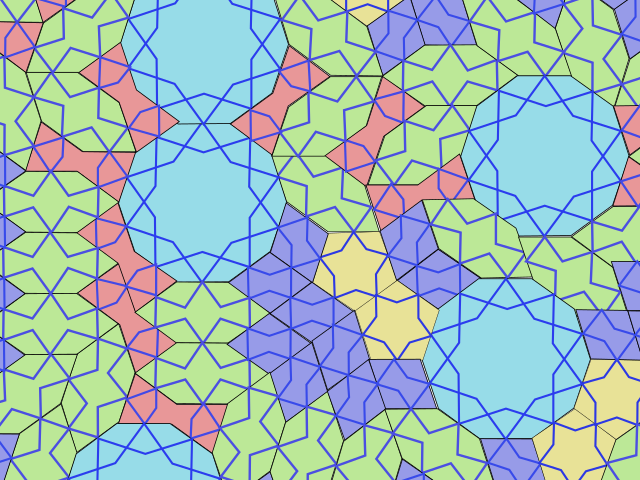Difference between revisions of "Language/Multiple-languages/Culture/Traditional-Symbols-and-Motifs:-Central-Asia"
< Language | Multiple-languages | Culture
Jump to navigation
Jump to search
(→Girih) |
|||
| (2 intermediate revisions by the same user not shown) | |||
| Line 1: | Line 1: | ||
{{Traditional-Symbols-and-Motifs}} | {{Traditional-Symbols-and-Motifs}} | ||
== ''Girih'' == | == ''Girih'' == | ||
https://upload.wikimedia.org/wikipedia/commons/thumb/5/50/Girih_tiles2.svg/640px-Girih_tiles2.svg.png | https://upload.wikimedia.org/wikipedia/commons/thumb/5/50/Girih_tiles2.svg/640px-Girih_tiles2.svg.png | ||
https://upload.wikimedia.org/wikipedia/commons/thumb/d/d6/Samarkand_Shah-i_Zinda_Tuman_Aqa_complex_cropped2.jpg/375px-Samarkand_Shah-i_Zinda_Tuman_Aqa_complex_cropped2.jpg | https://upload.wikimedia.org/wikipedia/commons/thumb/d/d6/Samarkand_Shah-i_Zinda_Tuman_Aqa_complex_cropped2.jpg/375px-Samarkand_Shah-i_Zinda_Tuman_Aqa_complex_cropped2.jpg | ||
== Islamic Star == | == Islamic Star == | ||
https://upload.wikimedia.org/wikipedia/commons/thumb/a/ab/Rub_El_Hizb.svg/240px-Rub_El_Hizb.svg.png | https://upload.wikimedia.org/wikipedia/commons/thumb/a/ab/Rub_El_Hizb.svg/240px-Rub_El_Hizb.svg.png | ||
https://upload.wikimedia.org/wikipedia/commons/thumb/9/9b/El%C3%A9ment_de_d%C3%A9cor_du_mausol%C3%A9e_dAlim_Nesefi_%28Shah-i-Zinda%2C_Samarcande%29_%286009389583%29.jpg/360px-El%C3%A9ment_de_d%C3%A9cor_du_mausol%C3%A9e_dAlim_Nesefi_%28Shah-i-Zinda%2C_Samarcande%29_%286009389583%29.jpg | https://upload.wikimedia.org/wikipedia/commons/thumb/9/9b/El%C3%A9ment_de_d%C3%A9cor_du_mausol%C3%A9e_dAlim_Nesefi_%28Shah-i-Zinda%2C_Samarcande%29_%286009389583%29.jpg/360px-El%C3%A9ment_de_d%C3%A9cor_du_mausol%C3%A9e_dAlim_Nesefi_%28Shah-i-Zinda%2C_Samarcande%29_%286009389583%29.jpg | ||
| Line 27: | Line 16: | ||
! Old Turkic | ! Old Turkic | ||
|- | |- | ||
| 𐱃𐰢𐰍𐰀 | |</div>𐱃𐰢𐰍𐰀<div style="text-align:right"> | ||
|} | |} | ||
More at https://ru.wikipedia.org/wiki/%D0%A2%D0%B0%D0%BC%D0%B3%D0%B0#%D0%9A%D0%B0%D0%B7%D0%B0%D1%85%D1%81%D0%BA%D0%B8%D0%B5_%D1%82%D0%B0%D0%BC%D0%B3%D0%B8 | More at https://ru.wikipedia.org/wiki/%D0%A2%D0%B0%D0%BC%D0%B3%D0%B0#%D0%9A%D0%B0%D0%B7%D0%B0%D1%85%D1%81%D0%BA%D0%B8%D0%B5_%D1%82%D0%B0%D0%BC%D0%B3%D0%B8 | ||
{| class="wikitable" | {| class="wikitable" | ||
!division | !division | ||
| Line 43: | Line 31: | ||
|https://upload.wikimedia.org/wikipedia/commons/thumb/c/c4/Kazakh_Tamga_46.svg/100px-Kazakh_Tamga_46.svg.png | |https://upload.wikimedia.org/wikipedia/commons/thumb/c/c4/Kazakh_Tamga_46.svg/100px-Kazakh_Tamga_46.svg.png | ||
|} | |} | ||
{{Traditional-Symbols-and-Motifs}} | |||
==Other lessons== | ==Other lessons== | ||
Latest revision as of 13:11, 22 February 2024

Girih[edit | edit source]


Islamic Star[edit | edit source]


Tamga[edit | edit source]
| Old Turkic |
|---|
| 𐱃𐰢𐰍𐰀 |
| division | symbol |
|---|---|
| Middle Zhuz | 
|
| Senior Zhuz | 
|

Other lessons[edit | edit source]
- Romanisations
- Text Processing Tools
- Internet Blogs
- Traditional Architectures: Southern Europe
- Traditional Symbols and Motifs
- Major Political Parties and Religions
- Traditional Symbols and Motifs: Western Europe
- Traditional Symbols and Motifs: Southern Europe
- Timelines by Country
- Traditional Architectures: Polynesia
- Ranking of countries by cost of living in the world
- Introduction to Common Han Characters
- Cities with the best quality of life
- Traditional Symbols and Motifs: Southern America
- Internet Courses